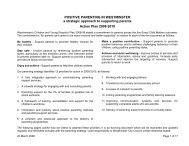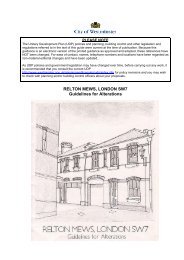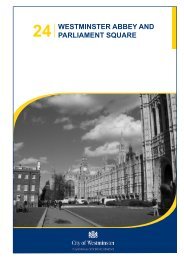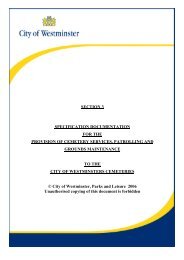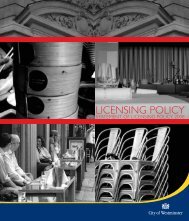Westminster Open Spaces Noise Study 2008 Final Report
Westminster Open Spaces Noise Study 2008 Final Report
Westminster Open Spaces Noise Study 2008 Final Report
- No tags were found...
Create successful ePaper yourself
Turn your PDF publications into a flip-book with our unique Google optimized e-Paper software.
<strong>Westminster</strong> <strong>Open</strong> <strong>Spaces</strong> <strong>Noise</strong><strong>Study</strong> <strong>2008</strong>: <strong>Final</strong> <strong>Report</strong>8. Recommendations and Further Work8.1 Protection (and creation) of Tranquil <strong>Spaces</strong>8.1.1 Where quiet or relative quiet is deemed to be a key factor in determining the tranquillity ofan open space then it will be necessary to safeguard this. For larger sites, quiet zones canbe designated and regularly monitored (both subjectively by park staff and objectively usingnoise measurements). These can be sited furthest away from noise sources or noisemitigation can be employed. For smaller sites, noise mitigation may be possible;alternatively masking with positive sound may be more appropriate.8.1.2 The enhancement of existing positive sounds or introduction of a soundscape feature canbe beneficial to tranquillity and can be considered as a positive soundscape. These caninclude natural and man made sounds.8.1.3 To protect the acoustic elements of tranquil open spaces the planning authority shouldinsist on a noise impact assessment for any proposed development that may encroach onan open space at which acoustic tranquillity is considered an important feature. Note thiscould link in with the Environmental <strong>Noise</strong> Directive (END) open space strategy.8.2 Mitigation8.2.1 Given that traffic noise dominated at most sites, re-routing or calming traffic, particularly attimes when parks are most used may be an option, however this may simply shift a noiseproblem to another set of receptors. Given that open spaces are largely used duringdaytime, the redistribution of traffic away from the daytime period with increase at nighttime may be beneficial, providing there are no other receptors close to parks that could beimpacted by such an approach. The use of speed restrictions, traffic calming measures,restrictions on HGV and LGV movements and the use of lower noise road surfaces canalso be considered, where these are not already used. <strong>Noise</strong> barriers may prove suitable atsome sites. In the context of an open space, green barriers and earth bunds are likely to bemore appropriate visually than conventional highway barriers fabricated from timber, metalor concrete panels.8.2.2 <strong>Open</strong> spaces could have designated, managed and protected quiet zones. These couldinclude the positive soundscapes as described above and include noise mitigation. Theseshould be sited as far from noise sources as practical. Mitigation in the forms of barriers(particularly green barriers) or bunds could be used.8.2.3 Signs stating that these are quiet areas/zones could be employed. These should state thatthese areas are for quiet use and people should refrain from making unnecessary noise.The use of quiet activities, for example, reading, meditation and Ti Chi could be promoted.8.3 Natural Sounds8.3.1 Natural sounds can be considered as part of a positive soundscape and can add totranquillity. Natural sounds can be split into:• The habitat and vegetation assemblages that will create pleasant sound themselvessuch as wind (or other weather effects) or generated by people walking throughthem (rustling through leaves, water flowing over rocks, the crunch of gravel or theswish of long grass as one walks through it etc) and;D121316/R1/0238Scott Wilson LtdMarch 2009





